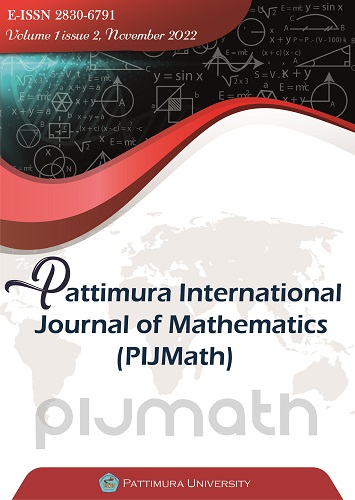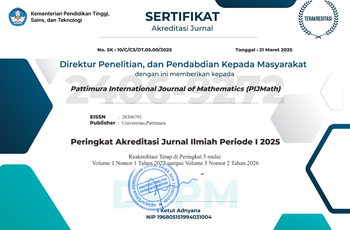Zero Inflated Poisson Regression Analysis in Maternal Death Cases on Java Island
Abstract
The basic regression model used to analyze the count data is the Poisson regression.. However, applying the Poisson regression model is unsuitable for excess zero data because it can cause overdispersion where the variance data is greater than its mean. One of the developments of the Poisson regression model can overcome this condition, Zero Inflated Poisson Regression (ZIP). In the health sector, the death of pregnant women on the Java island is an event that still rarely occurs and forms an excess zero data structure. However, the analysis of cases of maternal mortality using ZIP regression has never been studied in more depth. In this article, the maternal mortality cases in Java were modelled using ZIP regression to specify the variables that had a significant effect. The initial analysis results indicated the occurrence of overdispersion due to excess zero where there are 52% zero values in the data. The ZIP regression applied in this research provides enhancements to the Poisson regression based on the Vuong test. The results showed that the variables that had a significant effect on the maternal death cases in Java in the count model are the percentage of maternal health service coverage and the percentage of coverage of postpartum visit coverage, while in the zero-inflation model, the percentage of deliveries in health facilities and the percentage of obstetric complications treatmentDownloads
References
R.H. Myers, Classical and modern regression with applications, Boston (Mass.): PWS-KENT, 1990.
W. Wang and F. Famoye, “Modeling household fertility decisions with generalized Poisson regression,” J. Popul. Econ., vol. 10, no. 3, pp. 273–283, August 1997
D. Handayani, A. F. Artari, W. Safitri, W. Rahayu, and V. M. Santi, “Count Regression Models for Analyzing Crime Rates in the East Java Province,” J. Phys. Conf. Ser., vol. 2123, no. 1, October 2021
S. Coxe, S. G. West, and L. S. Aiken, “The analysis of count data: A gentle introduction to poisson regression and its alternatives,” J. Pers. Assess., vol. 91, no. 2, pp. 121–136, February 2009
N. Jansakul and J. P. Hinde, “Score test for zero-inflated poisson models,” Comput. Stat. Data Anal., vol. 40, no. 1, pp. 75–96, February 2002
A. Agresti, Foundations Linear Generalized Linear Models. Canada, 2015.
A. C. Cameron and P. K. Trivedi, Regression Analysis of Count Data, 1st ed. Cambridge, New York, Melbourne, Madrid, Cape Town, Singapore, São Paulo: Cambridge University Press, New York, 1998.
Y. Mouatassim and E. H. Ezzahid, “Poisson regression and Zero-inflated Poisson regression: application to private health insurance data,” Eur. Actuar. J., vol. 2, no. 2, pp. 187–204, October 2012
N. Fittriyah, A. F. Hadi, and Y. S. Dewi, “Pemodelan Jumlah Kematian Akibat Difteri di Provinsi Jawa Timur dengan Regresi Binomial Negatif dan Zero-Inflated Poisson,” Pros. Semin. Nas. Mat., no. November, pp. 201–214, November 2014
K. RI, Health Statistics. Jakarta: Kementerian Kesehatan RI, 2020.
R. Shier, “Statistics : 1 . 4 Chi-squared goodness of fit test Example : The Poisson Distribution,” vol. 75, pp. 1–2, 2004
J. M. Hilbe, Modeling Count Data. Avenue of the Americas, New York: Cambridge University Press, 2014.
W. Tang, H. He, and X. M. Tu, Applied categorical and count data analysis. CRC Press, 2012.
G. Rodriguez, “Models for Count Data With Overdispersion,” Princet. Stat.,pp. 1–7, November 2013
M. Bimali, S. T. Ounpraseuth, and D. K. Williams, “Impact of magnitude of zero inflation of covariates on statistical inference and model selection,” J. Stat. Appl. Probab., vol. 10, no. 2, pp. 287–292, July 2021
M. Ridout, C. G. B. Demetrio, and J. Hinde, “Models for count data with many zeros Martin,” Int. Biometric Conf., vol. 5, no. 1, December 1998
D. Lambert, “Zero-inflated poisson regression, with an application to defects in manufacturing,” Technometrics, vol. 34, no. 1, pp. 1–14, February 1992
A. H. Lee, K. Wang, and K. K. W. Yau, “Analysis of zero-inflated poisson data incorporating extent of exposure,” Biometrical J., vol. 43, no. 8, pp. 963–975, December 2001
S. S. Wilks, “The Large-Sample Distribution of the Likelihood Ratio for Testing Composite Hypotheses,” The Annals of Mathematical Statistics, vol. 9, no. 1, pp. 60-62, March 1938
M. Friendly, D. Meyer, and A. Zeileis, “Discrete data analysis with R: Visualization and modeling techniques for categorical and count data,” Discret. Data Anal. with R Vis. Model. Tech. Categ. Count Data, pp. 1–525, April 2015
A. Agresti, Categorical Data Analysis, Second Edi. Canada: John Wiley & Sons, Inc., Hoboken, New Jersey, 2002.
A. R. M. Izati, “Trend Cakupan Kunjungan Ibu Hamil (K4) Dan Pertolongan Persalinan Oleh tenaga Kesehatan Di Propinsi Jawa Timur,” J. Ilm. Kesehat. Media Husada, vol. 7, no. 1, pp. 1–10, March 2018
F. Sustini, S. Andajani, and A. Marsudiningsih, “Pengaruh Pendidikan Kesehatan, Monitoring, dan Perawatan Ibu Pascapersalinan terhadap Kejadian Morbiditas Nifas di Kabupaten Sidoarjo dan Lamongan Jawa Timur,” Indones. Bull. Heal. Res., vol. 31, no. 2, pp. 72–82, June 2003
A. I. Fibriana, Faktor – Faktor Risiko Yang Mempengaruhi Kematian Maternal. 2007. [Online].
I. A. Mutfi and V. Ratnasari, “Pemodelan Faktor-Faktor yang Mempengaruhi Jumlah Kematian Ibu di Jawa Timur Menggunakan Geographically Weighted Generalized Poisson Regression,” J. Sains dan Seni ITS, vol. 7, no. 2, 2019.
Copyright (c) 2022 Vera Maya Santi, Defina Ambarwati, Bagus Sumargo

This work is licensed under a Creative Commons Attribution-NonCommercial 4.0 International License.
The author(s) hold the copyright of the published article without restriction. This policy means that the journal allows the author(s) to hold and retain publishing rights without restrictions.
The author(s) holds the copyright of published articles without limitation. This policy means that the journal allows the author to hold and retain publishing rights without restrictions. Journal editors are given the copyright to publish articles in according to agreement signed by the author and also include statement of originality of the article


.jpg)












 This work is licensed under a
This work is licensed under a 